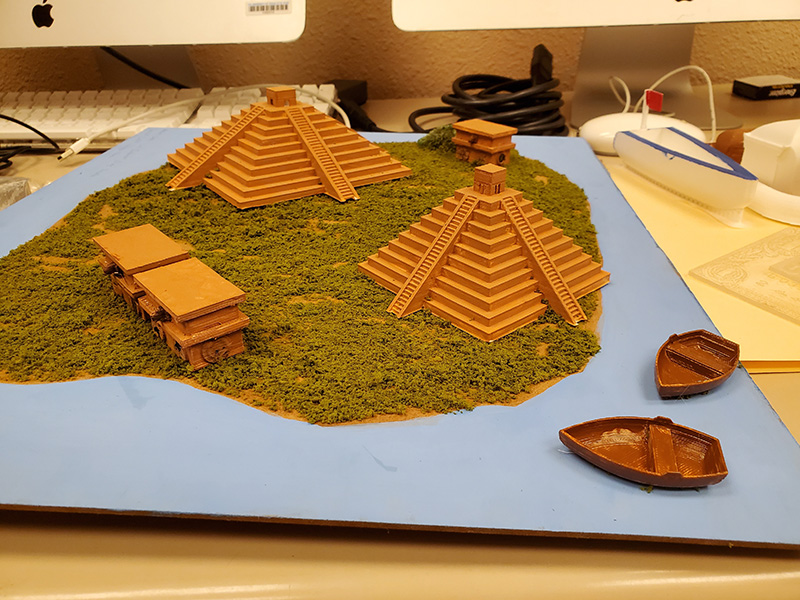Exhibit Exemplifies Novel Approach to UTEP History Class
Last Updated on May 06, 2019 at 12:00 AM
Originally published May 06, 2019
By Daniel Perez
UTEP Communications
The benefits of using different technologies and art forms to engage students in an entry-level history class at The University of Texas at El Paso is the basis of "History in 3D," an exhibit that opens May 8, 2019, in UTEP's Centennial Museum.

About 50 small-scale items created with a 3D printer as well as a handful of videos and a virtual reality walk-through make up the display in the museum’s Pop-Up Gallery. There will be a reception from 4 to 6 p.m. with a presentation starting at 5:15 p.m. The show closes May 31, 2019.
Miguel Juárez, Ph.D., the adjunct professor who developed the curriculum with UTEP’s Academic Technologies, said he based his concept on the continuous infiltration of artificial intelligence in the lives of U.S. citizens. He thought most of his History 1301 students, who usually are incoming freshmen, would be knowledgeable about manufacturing technology, augmented reality, graphic novels, iBooks or edited video/audio. It turns out about half of his approximately 270 students were familiar with these technologies or formats, but most were eager to learn about them and apply that knowledge.
“They were excited at the prospect,” Juárez said a few days before the exhibit opened. “The students were motivated. It’s a little extra work, but it is important to introduce technology in the classroom. Students learn what’s possible. There are just so many pluses to this.”
The project led to the creation of many interesting 3D representations that included gallows and structures tied to the Salem witch trials, Mayan and Aztec pyramids, slave ships, the Gettysburg battle site, a replica of the Ysleta del Sur Mission, and a liberty board game based on Monopoly. A handful of student groups decided to create historical videos and at least one music video about U.S. presidents.
On top of the technical skills, Juárez said that the students used such “soft skills” as communication, cooperation and time management. They exercised their “outside-the-box” thinking to solve challenges as a group where each member brought different talents.
Sam Brunk, Ph.D., professor and chair of the Department of History, said he was pleased that Juárez tried something new in the classroom that has tremendous potential to benefit students.
“This is the kind of innovation that makes history more accessible to a wider range of students,” said Brunk, who added that he looks forward to seeing the exhibit. “It grabs the interest of beginning students. It’s great when these things work out.”
Mike Pitcher, director of Academic Technologies, said he welcomed the opportunity to work with Juárez to expose students to new technology at the GAIA Makerspace studio, the revamped ATLAS Lab on the second floor of the Undergraduate Learning Center. GAIA is a word from Greek mythology that represents the personification of the primal Mother Earth.
“This concept allows students to reimagine history beyond facts and reports,” said Pitcher, who added that the types of technology GAIA offers are expanding to all fields. “It allows them to build real-world skills as they do their research; skills that they can use in the future, regardless of their majors. Our goal (at GAIA) is to grow student skills, whether their interests are in the arts, sciences or engineering.”
Vi Nguyen, a sophomore clinical laboratory science major, said she thought the class would be a PowerPoint lecture where she spent most of her time taking notes, but quickly realized that it was more interactive and project based. The Los Angeles, California, native said she was unfamiliar with the technology introduced in the class, but she did her best to keep up.
Her team focused its research on the Salem witch trials of the 1690s. Their project included a report and a 3D-printed medallion linked to witches of the past.
“I thought it was cool to use technology,” Nguyen said. “It was a unique way to learn. It made the class more fun and entertaining. We were taught what we needed to learn, but in a creative way that allowed students to be fully immersed in the topics.”
She said this experience has given her a more creative outlook to her studies and given her the confidence to use these new tools when she takes her biology and chemistry courses. She added that she expects to use that technology to develop models to help her visualize diseases and abnormalities as a student and a professional in a hospital lab.
“It is a great way to express ideas,” Nguyen said.